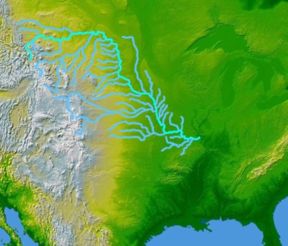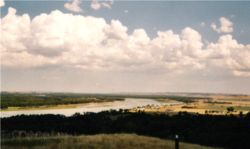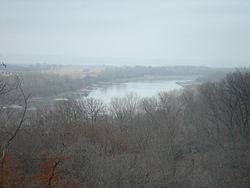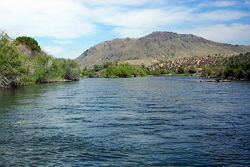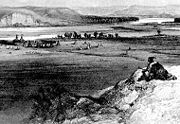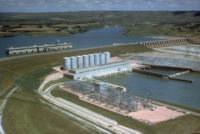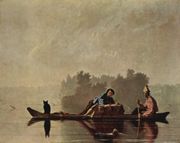Missouri River
2008/9 Schools Wikipedia Selection. Related subjects: North American Geography
| Missouri River | |
|---|---|
| The Missouri River in green, and its tributaries in blue | |
| Origin | Confluence of Madison River and Jefferson River, near Gallatin River, in Gallatin County, Montana. |
| Mouth | Coordinates: Mississippi River, near St. Louis, in St. Charles County, Missouri |
| Basin countries | United States of America, Canada |
| Length | 2,540 miles (4,090 km) 2,341 miles (3,767 km) |
| Source elevation | 4,042 feet (1,232 m) |
| Mouth elevation | 404 feet (123 m) |
| Avg. discharge | Great Falls: 292 ft³/s Pierre: 16,000 ft³/s Sioux City: 36,830 ft³/s |
| Basin area | 529,350 square miles (1,371,000 km²) |
The Missouri River (Éˀometaaˀe in Cheyenne) is a tributary of the Mississippi River, and the longest river in the United States of America. The Missouri begins at the confluence of the Madison, Jefferson, and Gallatin rivers in Montana, and flows through its valley south and east into the Mississippi north of St. Louis, Missouri. At 2,540 miles (4,090 km) in length, it drains about one-sixth of the North American continent. The Missouri in its original natural meandering state was the longest river in North America. Nearly 72 miles of the river have been cut off in channeling and so it is now comparable in length to the Mississippi River. The combination of the two longest rivers in North America forms the fourth longest river in the world.
At its confluence, the Missouri nearly doubles the volume of the Mississippi, accounting for 45 percent of the flow at St. Louis in normal times and as much as 70 percent of the flow during some droughts. It is the second-largest tributary by volume of the Mississippi, trailing the Ohio.
Course
The longest river in the United States of America. Heads in Montana at the junction of the Jefferson River and the Madison River, near the mouth of the Gallatin River, then flows generally South-East to the Mississippi River North of St. Louis, Missouri. Forms parts of the South Dakota-Nebraska, Nebraska-Iowa, Nebraska-Missouri and Kansas-Missouri boundaries. The lowest elevation in Nebraska at 840 feet near Richardson.
Overview
The headwaters of the Missouri are in the Rocky Mountains of southwestern Montana, near the small town of Three Forks, rising in the Jefferson, Madison, and Gallatin rivers. The longest headwaters stream, and thus the Missouri's hydrologic source, likely begins at Brower's Spring, which flows to the Jefferson by way of several other named streams. From the confluence of its main tributaries near the city of Three Forks, the Missouri flows north through mountainous canyons, emerging from the mountains near Great Falls, where a large cataract historically marked the navigable limit of the river. It flows east across the plains of Montana into North Dakota, then turns southeast, flowing into South Dakota, and along the north and eastern edge of Nebraska, forming part of its border with South Dakota and all of its border with Iowa, flowing past Sioux City and Omaha. It forms the entire boundary between Nebraska and Missouri, and part of the boundary between Missouri and Kansas. At Kansas City, it turns generally eastward, flowing across Missouri where it joins the Mississippi just north of St. Louis.
The extensive system of tributaries drain nearly all the semi-arid northern Great Plains of the United States. A very small portion of southern Alberta, Canada and south-western Saskatchewan is also drained by the river through its tributary, the Milk. Another, separate area, in southern Saskatchewan is drained by another Missouri tributary, the Poplar River.
The river roughly follows the edge of the glaciation during the last ice age. Most of the river's longer tributaries stretch away from this edge, with their origins towards the west, draining portions of the eastern Rockies.
Headwaters
The Missouri in name officially begins at Missouri Headwaters State Park at 4,045 feet in Montana at the confluence of the Jefferson River and Madison River. The Gallatin River joins the river about 0.6 of a mile downstream as it flows northeast. The Jefferson River originates in southwest Montana near the Continental Divide. The Madison and Gallatin Rivers flow out of northwest Wyoming to meet the Jefferson River.
Meriwether Lewis in his journal entry on July 28, 1805 wrote:
- Both Capt. C. and myself corresponded in opinon with rispect(sic) to the impropriety of calling either of these [three] streams the Missouri and accordingly agreed to name them after the President of the United States and the Secretaries of the Treasury and state.
The Lewis and Clark decision not to call the Jefferson the Missouri has spurred debate over what is the longest river in North America since the Missouri and Mississippi are nearly identical in length. With the Jefferson the Missouri would be the longest river.
Lewis (who had followed the Jefferson River to the Beaverhead River) said that on August 12, 1805, he visited Beaverhead tributary of Trail Creek just above Lemhi Pass on the Continental Divide in the Beaverhead Mountains on the Montana and Idaho border at around 8,600 feet which he described:
- the most distant fountain of the waters of the mighty Missouri in surch(sic) of which we have spent so many toilsome days and wristless(sic) nights.
However in 1888 Jacob V. Brower, who had championed turning the headwaters of the Mississippi River into a Minnesota state park, visited a site in Montana which today is believed to be the furthest point on the Missouri -- now called Brower's Spring. Brower published his finding in 1896 in "The Missouri: It's Utmost Source."
The site of Brower's Spring at around 8,800 feet in the Centennial Mountains. The site now commemorated by a rock pile at the source of Hellroaring Creek which flows into Red Rock River and then into Clark Canyon Reservoir where it joins the Beaverhead then the Big Hole River before ultimately hooking up with the Jefferson.
Mouth
The Missouri enters the Upper Mississippi River near its mile 195. The elevation is approximately 400 feet. The confluence is ringed by Camp Dubois which is now part of Lewis and Clark State Memorial Park in Illinois; Columbia Bottom Conservation Area on the south bank of the Missouri in St. Louis and on the north bank of the Missouri by the Edward "Ted" and Pat Jones-Confluence Point State Park in West Alton, Missouri.
Natural History
Geology
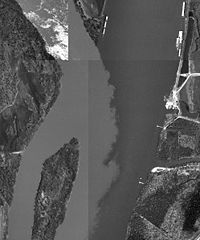
The river is nicknamed "Big Muddy" and also "Dark River" because of the high silt content. The river meanders from bluff to bluff in the flat Midwestern states, leading to the nickname the "Wide Missouri".
History
Name
The popular but erroneous conception that the name means "muddy water" arose from the fact that Marquette gave it the indigenous name "Pekitanoui" meaning "muddy". Early white explorers first called the stream "Missouri" after a tribe of Indians who lived on its banks and whose name meant "people with wooden canoes." (Robert Ramsay placename file). The variant name "Emasulia Sipiwi" means "river of boatmen" in the Peoria language.
Also known as: Big River, Emasulia sipiwi, Eomitai, Katapan Mene Shoska, Le Riviere des Missouri, Mini Sose, Missoury River, Ni-sho-dse, Nudarcha, Rio Misuri, Riviere de Pekitanoni, Riviere de Saint Philippe, Big Muddy, Le Missoui, Le Missouri, Le Riviere des Osages, Missures Flu, Miz-zou-rye River, Niutaci, Pekitanoui, River of the West, Yellow River.
Exploration
Jolliet and Marquette
The first Europeans to see the river were the French explorers Louis Jolliet and Jacques Marquette who shortly after looking at the Piasa petroglyph painting on the bluffs of Mississippi River above Alton, Illinois heard the Missouri rushing into the Mississippi.
Marquette wrote:
- While conversing about these monsters sailing quietly in clear and calm water, we heard the noise of a rapid into which we were about to run. I never saw anything more terrific, a tangle of entire trees from the mouth of the Pekistanoui with such impetuosity that one could not attempt to cross it without great danger. The commotion was such that the water was made muddy by it and could not clear itself.
- Pekitanoui is a river of considerable size, coming from the northwest, from a great distance; and it discharges into the Mississippi. There are many villages of savages along this river, and I hope by this means to discover the Vermillion or California Sea.
Marquette and Joliet referred to the river as "Pekistanoui" and they made a reference to a tribe who lived upstream on the river as "Oumessourita" which was pronounced "OO-Missouri."), (meaning "those who have dugout canoes") This was the Illinois (tribe) name for the Missouri (tribe) whose village was nearly 200 miles upstream near Brunswick, Missouri.
Marquette wrote that natives had told him that it was just a six day canoe trip up the river (about 60 miles) where it would be possible to portage over to another river that would take people to California.
Jolliet and Marquette never explored the Missouri beyond its mouth.
Bourgmont
The Missouri remained formally unexplored and uncharted until Étienne de Veniard, Sieur de Bourgmont wrote "Exact Description of Louisiana, of Its Harbors, Lands and Rivers, and Names of the Indian Tribes That Occupy It, and the Commerce and Advantages to Be Derived Therefrom for the Establishment of a Colony" in 1713 followed in 1714 by "The Route to Be Taken to Ascend the Missouri River." In the two documents Bourgmont was the first to use the name "Missouri" to refer to the river (and he was to name many of the tributaries along the river based on the Native American tribes that lived on them). The names and locations were to be used by cartographer Guillaume Delisle to create the first reasonably accurate map of the river.
Bourgmont himself was living with the Missouri tribe at its Brunswick village with his Missouri wife and son. He had been on the lam from French authorities since 1706 when he deserted his post as commandant of Fort Detroit after he was criticized by Antoine Laumet de La Mothe, sieur de Cadillac for his handling of an attack by the Ottawa (tribe) in which a priest, a French sergeant and 30 Ottawa were killed. Bourgmont had further infuriated the French by illegally trapping and for immoral behaviour when he showed up at French outposts with his Native American wife.
However after Bourgmont's two documents, Jean-Baptiste Le Moyne, Sieur de Bienville, founder of Louisiana, said that rather than arresting Bourgmont they should decorate him with Cross of St. Louis and name him "commandant of the Missouri" to represent France on the entire river. Bourgmont's reputation was further enhanced when the Pawnee, who had been befriended by Bourgmont, massacred the Spanish Villasur expedition in 1720 near modern day Columbus, Nebraska which temporarily ended Spanish designs on the Missouri River and cleared the way for a New France empire stretching from Montreal, Canada to New Mexico.
After squabbling with French authorities over financing of a new fort on the Missouri and also suffering a yearlong illness, Bourgmont established Fort Orleans, which was the first fort and first longer term European settlement of any kind on the Missouri, in late 1723 near his home at Brunswick. In 1724 Bourgmont led an expedition to enlist Commanche support in the fight against the Spanish. In 1725 Bourgmont brought the chiefs of the Missouri River tribes to Paris to see the glory of France including the palaces of Versailles, and Fountainbleau and a hunting expedition on a royal preserve with Louis XV. Bourgmont was raised to the rank of the nobility, remained in France and did not accompany the chiefs back to the New World. Fort Orleans was either abandoned or its small contingent massacred by Native Americans in 1726.
It is unclear how far up the Missouri Bourgmont traveled. He is the documented first European discoverer of the Platte River. In his writings he described the blonde-haired Mandans, so it is possible that he made it as far north as their villages in central North Dakota.
MacKay and Evans
The Spanish took over the Missouri River in the Treaty of Paris (1763) that ended the French and Indian War/ Seven Years War. The Spanish claim to the Missouri was based on Hernando de Soto's "discovery" of the Mississippi River on May 8, 1541. The Spanish initially did not extensively explore the river and let French fur traders continue their activities although under license.
After the British began to exert influence on the Upper Missouri River via the Hudson's Bay Company, news of English incursions came following an expedition by Jacques D’Eglise in 1790. The Spanish chartered the "Company of Discoverers and Explorers of the Missouri" (popularly referred to as the "Missouri Company") and offered a reward for the first person to reach the Pacific via the Missouri. In 1794 and 1795 expeditions led by Jean Baptiste Truteau and Antoine Simon Lecuyer de la Jonchšre did not even make it as far north as the Mandan villages in central North Dakota.
The most significant expedition though was the MacKay and Evans Expedition of 1795-1797. James MacKay and John Evans were hired by the Spanish to search a route to the Pacific Ocean and to tell the British to leave the upper Missouri.
McKay and Evans established a winter camp about 20 miles south of Sioux City, Iowa on the Nebraska side where they built Fort Columbus. Evans went on to the Mandan village where he expelled British traders. While talking to Native Americans they pinpointed the location of the Yellowstone River (which they called "Yellow Rock").
They created a detailed map of the upper Missouri that was used by Lewis and Clark.
Lewis and Clark
On October 27, 1795, the United States and Spain signed Pinckney's Treaty giving American merchants the "right of deposit" in New Orleans, meaning they could use the port to store goods for export. The treaty also recognized American rights to navigate the entire Mississippi River.
In 1798 Spain revoked the treaty.
On October 1, 1800, the Spanish secretly returned Louisiana to the French under Napoleon in the Third Treaty of San Ildefonso. The transfer was so secret that the Spanish continued to administer the territory. In 1801 they restored the United States rights to use the river and New Orleans.
Thomas Jefferson, fearing the cutoffs could occur again, sought to negotiate with France to buy New Orleans for the asking price of $10 million. Napoleon countered with an offer of $15 million for all of the Louisiana Territory including the Missouri River. The deal was signed on May 2, 1803.
On June 20, 1803, Thomas Jefferson instructed Meriwether Lewis to explore the Missouri and look for a water route to the Pacific.
Although the deal was signed, Spain still balked at an American takeover, citing that France had never formally taken over the Louisiana Territory. Spain was to formally tell Lewis not to take the journey and expressly forbade Lewis from seeing the McKay and Evans map which was the most detailed and accurate of its time. Lewis was to gain access to it surreptitiously. To avoid jurisdictional issues with Spain they wintered in 1803-1804 at Camp Dubois on the Illinois (United States) side of the Mississippi.
Lewis and William Clark left on May 14, 1804 and returned to St. Louis on September 23, 1806.
American Frontier
The river defined the American frontier in the 19th century, particularly upstream from Kansas City, Missouri, where it takes a sharp eastern turn into the heart of the state of Missouri.
All of the major trails for the opening of the American West have their starting points on the river, including the California, Mormon, Oregon, and Santa Fe trails. The first westward leg of the Pony Express was a ferry ride across the Missouri at St. Joseph, Missouri. The first westward leg of the First Transcontinental Railroad was a ferry ride across the Missouri between Council Bluffs, Iowa and Omaha, Nebraska.
The Hannibal Bridge was the first bridge to cross the river when it opened in Kansas City in 1869, and was a major reason why Kansas City became the largest city on the river upstream from its mouth at St. Louis.
Extensive use of paddle steamers on the upper river helped facilitate European settlement of the Dakotas and Montana.
The Department of the Missouri, which was headquartered on the banks of the river at Fort Leavenworth, Kansas, was the military command centre for the Indian Wars in the region.
The northernmost navigable point on the Missouri before extensive navigation improvements was Fort Benton, Montana, at approximately 2,620 feet.
Economy
River modifications
Since the lower river meanders through a broad floodplain in Midwestern states, it has often changed course and in its wake left numerous oxbow lakes ( Big Lake is the largest such lake in Missouri). In the early 1800s the United States Supreme Court (which decides state border disputes) ruled that when the river changed course the border also changed (as happened with the Fairfax District at Kansas City, Kansas which switched from Missouri to Kansas.) However, in the late 1800s the Court began ruling on absolute boundaries, creating geographic oddities such as Carter Lake, Iowa, which is now a piece of Iowa on the west side of the Missouri between downtown Omaha and Eppley Airfield, and the French Bottoms in St. Joseph, Missouri, a piece of Missouri on the west of the river, requiring Missouri residents to go through Kansas in order to reach Rosecrans Airport.
In the 20th century, the upper Missouri was extensively dammed for flood control, irrigation, and hydroelectric power. After President Franklin D. Roosevelt signed the Flood Control Act of 1944, the Pick-Sloan Plan turned the Missouri River into the largest reservoir system in North America. There are six dams in four states: Fort Peck Dam in Montana; Garrison Dam in North Dakota; Oahe Dam, Big Bend Dam, and Fort Randall Dam in South Dakota; and Gavins Point Dam on the South Dakota-Nebraska border.
These dams were constructed without locks, so commercial navigation on the Missouri cannot proceed above the Gavins Point Dam. The Corps of Engineers maintains a 9-foot-deep (3 m) navigation channel for 735 miles (1183 km) between Sioux City, Iowa and St. Louis in non-winter months. The dams aid navigation on the lower river by reducing fluctuations in water levels.
Thirty-five percent of the Missouri River is impounded, 32 percent has been channelized, and 33 percent is unchannelized.
The only significant stretch of free-flowing stream on the lower Missouri is the Missouri National Recreational River section between Gavins Point Dam and Ponca State Park, Nebraska. This federally-designated " Wild and Scenic River" is among the last unspoiled stretches of the Missouri, and exhibits the islands, bars, chutes and snags that once characterized the "Mighty Mo".
The dikes, revetments, and levees constructed by the Corps of Engineers as part of the Missouri River Navigation and Flood Control Project have transformed the once sprawling and constantly changing river into a narrower, deeper, fixed channel designed to more easily maintain the 735 mile navigation channel. The river carries a large amount of silt and sand, but high water velocity in the navigation channel normally prevents settling out and sand bar accumulations. As a result, unlike the Mississippi River, the Missouri River rarely requires dredging to maintain the navigation channel. The huge amounts of sediment in the Big Muddy have long provided a free source of sand, mined by commercial dredgers to be used in concrete and asphalt for construction, mainly below Rulo, Nebraska. In recent years, the quantity of sand commercially dredged from the Missouri River has dramatically increased as Kansas City, Columbia, and St. Louis have grown. In 2000, 7.4 million tons of sand and gravel were dredged out of the navigation channel. As commercial sand dredging has increased, the Missouri River bed has gradually cut deeper into the flood plain. Between 1990 and 2005 the river around Kansas City, Missouri has degraded as much as 4.5 feet.
Traffic
Barge traffic has been steadily declining from 3.3 million tons in 1977 to 1.3 million tons in 2000. The declining barge traffic industry has stirred controversies over the management of the river and whether upstream dams should release more water to maintain commercial navigation standards.
Popular depictions
The American painter George Catlin traveled up the Missouri in the 1830s, making portraits of individuals and tribes of Native Americans. He also painted several Missouri River landscapes, notably " Floyd's Bluff" and " Brick Kilns", both from 1832.
The Swiss painter Karl Bodmer accompanied German explorer Prince Maximilian zu Wied-Neuwied from 1832 through 1834 on his Missouri River expedition. Bodmer was hired as an artist by Maximilian for the purpose of recording images of the Native American tribes that they encountered in the American West.
In 1843, the American painter and naturalist John James Audubon traveled west to the upper Missouri River and the Dakota Territory to do fieldwork for his final major opus, Viviparous Quadrupeds of North America. A typical example from this folio is "American Bison".
Missouri painter George Caleb Bingham immortalized the fur traders and flatboatmen who plied the Missouri River in the early 1800s; these same boatmen were known for their river chanties, including the haunting American folk song " Oh Shenandoah". Each verse of " Oh Shenandoah" ends with the line, "...'cross the wide Missouri."
The Missouri may be the setting of the Pete Seeger song Waist Deep in the Big Muddy. (There is considerable ambiguity as to location, however. Seeger sings that the action took place in "Loo-siana" and there is also a Big Muddy River in Illinois. One could not "press on" very far into the Missouri and remain only "waist deep.") The song is set in 1942, during training for World War II, but its image of a foolish captain who pushes his men further and further into a hopeless situation was clearly meant to parallel the Vietnam War. In the song, a Captain leading a squad on training maneuvers insists on crossing the titular river, insisting that it is safe to cross. The Captain sinks into the mud, drowns, and his squad turns back, led by the Sergeant who had questioned the Captain's orders.
A. B. Guthrie, Jr.'s popular Western novel The Big Sky (1947) tells the story of a group of men who, in the early 19th century, made the long journey up the Missouri from St. Louis to Montana. Howard Hawks made a film based on the book a few years later.
